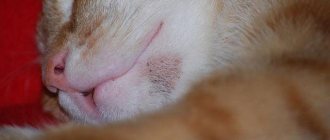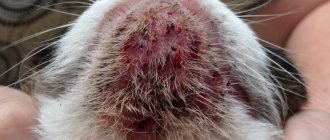Where does a cat get worms?
Not only stray animals can become infected with helminthiasis. Worms occur quite often in cats that live in apartments and private houses. Of course, free-ranging pets are at greatest risk of infection. Helminth eggs can be found on grass, sand and soil. They remain on the fur, and when the cat licks itself, it enters the digestive tract.
A person can bring parasite eggs into an apartment on his shoes or clothes.
There are other ways of infection with helminthic infestation:
- Eating raw river fish, meat and minced meat.
- Close contact with an infected animal. Helminth infections are transmitted by using a common tray or equipment.
- Some types of worms are transmitted to kittens through the milk of a nursing mother.
- Fleas and lice eaters are carriers of helminthiasis. If a cat has ectoparasites, the risk of infection with worms cannot be ruled out.
Types of helminths in cats
Worms that parasitize cats are divided into several groups:
- Roundworms. Otherwise they are called nematodes.
- Tapeworms (flatworms), or cestodes.
- Flukes are trematodes.
Round (nematodes)
The most common roundworm in cats is roundworms. There are two types of such worms:
- Toxocara cati;
- Toxacaris leonine.
These are light yellow cylindrical worms. Outwardly they look like spaghetti. The average length of these parasites is 7-15 cm. Roundworms settle primarily in the small intestine.
Hookworms are another type of helminthic infestation in cats. The size of parasites usually does not exceed 10 mm. These worms can even enter an animal's body through the skin. Habitat: small intestine.
Heartworms - this type of worms in cats is transmitted by mosquitoes during a bite. These worms can infect the subcutaneous tissue, muscle tissue, heart and lungs. The size of adult individuals reaches 30 cm in length.
Routes of infection
Roundworm eggs enter the body of cats mainly through nutrition:
- when eating raw meat and fish;
- while licking paws and fur.
The source of infection is most often sick animals, which release parasite eggs along with feces into the environment. Worms in a kitten can appear due to an infected mother who feeds her babies with breast milk.
Why are they dangerous?
Roundworms injure the intestinal mucosa and release toxic substances. This leads to poisoning of the body. In addition, they take away some of the cat's nutrients. As a result, exhaustion, anemia occurs, and the body's protective functions decrease. With ascariasis, blockage of the bile ducts and intestinal obstruction are possible.
How to notice
Signs of the presence of roundworms in cats are not immediately detected. Symptoms appear 2-4 weeks after infection. How to understand that your pet has helminths:
- the cat loses its appetite and loses weight;
- Allergic skin rashes may appear;
- diarrhea and constipation occur from time to time;
- there may be blood in the stool;
- the coat loses its well-groomed appearance and looks dull.
With dirofilariasis, the symptoms are specific - shortness of breath, fatigue, swelling. This clinical picture emerges if worms have affected the heart. In the ocular form of the disease, the eyelids become inflamed. If the worms have settled in the subcutaneous tissue, moving formations, ulcers are found on the body, and the hair in these places falls out.
Tape (cestodes)
This group includes worms with a flat body that looks like a ribbon, hence the name. The length of parasites can reach 70 cm. Their oral cavity is equipped with hooks. With their help, worms attach to the intestinal mucosa. As the worms grow, segments about the size of a grain of rice break off from the back of the worm and are passed in the infected animal's feces.
There are several types of tapeworms in cats:
- Cucumber tapeworm. The parasite reaches 50 cm in length and about 3 mm in width. The worm has 4 suckers and a proboscis with spine-like hooks. Its segments resemble cucumber seeds. The tapeworm is a parasite in the small intestine.
- Wide tape. The length of the worm can reach several meters. The intermediate hosts of the tapeworm are copepods and fish.
- Echinococcal tapeworm. These are worms no larger than 4 mm, the larvae of which live in the intestines of cats and dogs. Man, along with other animals, is an intermediate host of Echinococcus.
How do pets become infected?
Tapeworms enter a cat's body in a variety of ways. For example:
- cucumber tapeworm - when ingesting an infected flea or lice eater;
- wide tapeworm - when eating raw river fish;
- Infection with echinococcosis is possible through contact with the feces of a sick animal.
What is the danger
Tapeworms are dangerous to both cats and their owners. They injure the intestinal mucosa and poison the body with the products of their vital activity. Severe infection can cause anemia and blockage of the intestinal lumen.
Attention! A person can become infected with cestodosis from a sick cat if he does not follow the rules of personal hygiene - does not wash his hands after contact with the animal or touches fur contaminated with feces with his lips.
How to see
You can tell that a cat has tapeworms by the following signs:
- segments of helminths are occasionally found in feces;
- the cat has poor appetite;
- vomiting, diarrhea;
- allergic rashes;
- irritation in the anal area;
- apathy, fatigue.
Flukes (trematodes)
These are flat worms that are firmly attached to the cat’s internal organs using powerful suction cups. They can parasitize the liver, bile ducts and lungs. During their life, worms gradually destroy the tissues of internal organs.
The following fluke worms are found in cats:
- cat fluke is a worm up to 1.5 cm long.
- Paragonimus is a red-brown worm slightly more than 1 cm long and up to 0.5 cm wide.
Methods of infection
Cats can become infected with trematodiasis by eating uncooked fish. The development cycle of flukes is quite complex and involves the presence of several intermediate hosts. These could be slugs, snails, fish. In this regard, human infection from a cat is unlikely. Kittens pick up a parasitic infection through their mother's milk.
What amazes
Worms from this group parasitize the tissues of internal organs. For example, the cat fluke lives in the bile ducts. Paragonimus live in the lungs of cats, which is why they are also called pulmonary flukes.
How to determine
You can tell if a cat has worms from the fluke group by the following signs:
- the animal is stunted;
- there is a lack of appetite;
- vomiting occurs periodically, blood may be present in the stool;
- cough, difficulty breathing;
- yellowness of the skin and mucous membranes.
Are white worms dangerous for humans?
It all depends on the specific type of parasite. Thus, most cat roundworms are not dangerous to humans. A certain risk of infection exists only in the case of young children and the elderly, but even in their bodies the worms do not live for a long time; the immune system can handle them quite well. But with cestodes everything is not so simple.
The problem is that for some parasitic flatworms, humans can be not only the definitive host, but also an intermediate host, and this is very, very dangerous.
The danger lies in the larvae of parasites, which, having entered the body of the “lucky one,” are encapsulated in the muscles, climb into the internal organs, and even cases of the formation of parasitic cysts directly in the brain have been described.
Important! Alveococci and echinococci are deadly to humans!
So what should an owner do if he sees clumps of worms coming out of a cat in feces or vomit? First, you need to call your veterinarian right away. Secondly, when caring for a sick animal, you must strictly follow several simple rules:
- After any contact with the cat, you must wash your hands thoroughly.
- It is advisable to isolate the pet in a separate room, the floors of which should be washed daily, adding disinfectant compounds to the water.
- It is strongly recommended to burn the feces of a sick animal! If this is not possible, the contents of the litter box should at least be packed in thick plastic bags. In this way, it is possible to minimize the spread of parasite eggs in the external environment.
- When treating, you do not need to limit yourself to a single dose of medication. If the intensity of the infestation was strong, then after 10 days the pet’s feces are again taken for analysis. If even single eggs are detected, the anthelmintic treatment is repeated.
Symptoms of worms in cats
Timely detection of symptoms of helminthic infestation is a guarantee of successful treatment. Signs of helminthiasis differ depending on which organs are affected by worms. In adult cats with strong immune systems, the clinical picture may be mild.
Intestines
The following symptoms indicate that a cat has worms in its intestines:
- the presence of mucus in the stool;
- bloating and abdominal pain;
- vomit;
- loss of appetite;
- diarrhea alternating with constipation;
- increased thirst.
Liver
If worms have infected the liver, symptoms in cats appear differently:
- vomiting bile;
- the skin, mucous membranes and sclera acquire a yellow tint;
- pain on palpation under the ribs on the right.
Heart and lungs
By these signs you can find out about worm damage to the heart and lungs:
- temperature increase;
- fast fatiguability;
- dyspnea;
- noisy breathing;
- cough;
- vomit.
central nervous system
When infected with worms, symptoms may appear that indicate damage to the spinal cord or brain:
- excessive excitement;
- convulsions;
- paralysis of individual parts of the body;
- impaired coordination of movements;
- fainting;
- involuntary urination or bowel movements.
Excretory system
Worms in cats rarely parasitize the genitourinary organs. If your pet begins to go to the toilet more often or less often than usual, and blood appears in the urine, you need to examine it.
The first symptoms of opisthorchiasis
The first signs appear when the protective function of the immune system decreases. In the early stages, the patient experiences the appearance of general weakness and sweating increases. The acute form of opisthorchiasis manifests itself as follows:
- the appearance of insomnia and nervousness;
- pain in the right hypochondrium;
- pain in the back and abdomen;
- presence of asthmatic bronchitis;
- feeling of body aches and fever;
- the appearance of allergic rashes on the skin;
- the presence of flatulence, nausea, vomiting, abdominal pain, general discomfort;
- a sharp decrease in appetite, too liquid stool consistency.
When examining the body, the doctor may detect an enlarged liver and an increased number of eosinophils in a general blood test.
Symptoms of opisthorchiasis in adults are somewhat different from the first signs of children. In little fidgets, the disease is expressed in the manifestation of persistent allergosis, intoxication of the whole body and an immunosuppressive state. The temperature may also rise and last up to 2-3 weeks.
Symptoms in women are most pronounced during the menstrual cycle. If a woman has a parasite in her liver, her periods become very painful and her cycle becomes unstable.
The effect of helminths on the animal
Worms are harmful to a cat's health. They deprive their prey of nutrients and vitamins. This leads to decreased immunity and anemia. The animal gradually weakens and becomes vulnerable to various infectious diseases.
Mechanical
Worms damage internal organs and tissues with their suckers. This often leads to the development of an inflammatory process and even necrosis. When there is a large accumulation of worms in the intestine, the walls become stretched and the lumen becomes blocked. Some animals die due to ruptures of internal organs.
Biochemical
Toxic substances that worms secrete poison the body. First, intoxication leads to allergic reactions. If no measures are taken, the cat will develop chronic dermatitis. Due to the constant presence of toxins in the body, the functioning of the liver and kidneys will be impaired.
Stages of acute opisthorchiasis
When it comes to acute opisthorchiasis, it is divided into 4 classes.
- Typhoid-like course - there are symptoms of pancreatitis, jaundice and hepatitis, an enlarged liver, gastritis, eosinophils in the blood up to 90%.
- Hepatocholangetic type - pancreatitis, aching abdominal pain, the liver is affected, the function of the pancreas is impaired.
- Gastroenterological – the presence of enterocolitis, stomach ulcers, erosive gastritis, stool disorders are observed.
- Damage to the respiratory tract - the presence of asthmatic-type bronchitis, pleurisy and pneumonia.
Diagnostics
It is impossible to determine on your own what kind of worms a domestic cat has. Before starting treatment at home, you need to examine your pet. The following diagnostic methods are available in veterinary clinics:
- fecal analysis for helminth eggs;
- chest x-ray to assess the condition of the lungs;
- Ultrasound of the heart and abdominal organs;
- general blood test - shows the content of eosinophils in the blood, which increase with helminthic infestations.
Folk remedies and prevention
Traditional remedies for deworming in cats have side effects, but folk remedies are not welcomed by veterinarians. This is explained by the lack of evidence of the therapeutic effect and increased activity of parasites. As a result, worms begin to migrate throughout the body, creating discomfort and increased trauma to internal organs.
Prevention at home consists of giving anthelmintic drugs to adults once every 3-4 months, with mandatory flea treatment. In cats under one year of age, the frequency of drug administration is associated with vaccination. Your veterinarian will tell you what to give cats for worms! Feeding raw meat and fish is not prohibited, but with this type of feeding, worm prevention is mandatory.
Medicines for helminths
A veterinarian must treat worms in cats. You cannot select the medicine yourself, since different substances act on different types of helminths. Anti-worm medications are divided into two groups: for external and internal use.
The first group includes drops on the withers. The second includes tablets, suspensions, pastes. There are single-component medications on sale that are used to treat one type of helminthiasis, and multicomponent or combined ones. Such drugs are used for mixed helminthic infestations. They are also often used for prevention.
Important! Before starting treatment, it is advisable to treat the cat for external parasites, since they are often the carriers of helminth infections. Otherwise, re-infection will occur after some time.
Pills
To remove worms from a cat, in most cases it is enough to give her the medicine twice with an interval of 10-14 days. It is important to follow the dosage, which is calculated based on the weight of the animal. Proven and effective remedies for worms in cats in the form of tablets are sold in veterinary pharmacies:
- Drontal. Destroys round and tapeworms.
- Mibelmax. Effectively fights cestodes and nematodes.
- Piperazine. Medicine against roundworms.
- Pirantel. The medicine helps rid the cat of nematodes.
- Pratel. A medicine with a wide spectrum of action, destroys tapeworms, roundworms and flukes.
- Prazicide. Acts only on cestodes and nematodes.
- Vacation. A combined drug based on febendazole and praziquantel with a broad spectrum of action.
- Enwire. Effective against tapeworms and roundworms.
- Trontsil-K. A complex drug used for cestodes and nematodes.
To give a cat an anti-worm tablet, you need to place it on the very root of the tongue, holding the animal by the withers. Next, you need to close your mouth, throw back your head and stroke your neck with your fingers - this will help provoke a swallowing movement. After 10-14 days, the treatment should be repeated.
Attention! Anti-worm medications should not be given to pregnant or lactating cats, or to kittens under one month of age.
Drops on the withers
Some external preparations act on both skin parasites and helminths. These are liquid compositions that are applied to the withers:
- Profender;
- Advocate;
- Stronghold;
- Leopard.
Such medications are suitable for the treatment of certain types of worms in cats - nematodes and cestodes. They are ineffective against trematodes.
Pastes and suspensions
Many drugs that are available in tablet form are also available in the form of suspensions and pastes. They have a more pleasant taste and have a convenient dispenser. These include:
- Albendazole;
- Alvet;
- Kanikquantel plus;
- Prazicide plus.
It is more convenient to treat worms in kittens with a suspension - you can easily measure the required dose. The medicine is poured into the animal's cheek. It is important to ensure that the pet swallows the entire volume, otherwise the therapy may be ineffective.
Treatment
Treatment of the animal should be carried out under the supervision of a veterinarian. It is advisable that medications for cats infected with nematodes be selected by a specialist. This will allow you to quickly achieve a positive result and reduce the risk of side effects. In addition, drugs can be selected that are intended to restore the functioning of internal organs damaged by nematodes.
Preparations for internal and external use
Existing anthelmintics are extremely effective against roundworms. The most commonly used nematode treatments include:
- Mebenvent;
- Pyrantel;
- Fenbendazole;
- Piperazine;
- Phenothiazine;
- Proziquantel;
- Ivomek;
- Naftamon.
In most cases, 1 tablet is sufficient, but for preventive purposes, it may be recommended to take another dose to eliminate newly hatched nematodes. Additionally, your pet may be prescribed iron supplements, vitamins and protein supplements. To remove worms from an animal's fur, you can use special shampoos.
Traditional methods
It is advisable to use folk remedies only in the first degree of severity of helminthic infestation. Various formulations based on medicinal herbs can not only eliminate nematodes, but also suppress the signs of ascariasis and toxascariasis.
To remove parasites, you can use a decoction of wormwood. To prepare the product you need approximately 1 tbsp. Pour this medicinal plant into a glass of hot water. The mixture should be boiled for 5 minutes, strained and cooled to room temperature. Some cats drink the decoction on their own. However, if the animal does not want to take this medicine, it must be poured into the pet's mouth with a syringe without a needle every day. In addition, to eliminate nematodes, you can use decoctions of medicinal chamomile and fennel.
An infusion of tansy has a good anthelmintic effect. Both dry and fresh flowers are suitable for preparing a healing remedy. You need to pour 1 tbsp into a thermos. this herbal component and pour a glass of boiling water. The product should be infused for an hour. After this, the infusion must be strained. The composition should be given in approximately 1 tbsp. 3 times a day at least an hour before meals.
In case of severe helminthic infestations, carrot enemas can benefit the animal’s body. About 20 ml of carrot juice should be injected into the cat's anus. The procedure should be carried out once a day in the morning, 1 hour before feeding. If your cat consumes natural food, you can add a small amount of garlic to her food. This natural component helps eliminate nematodes.











